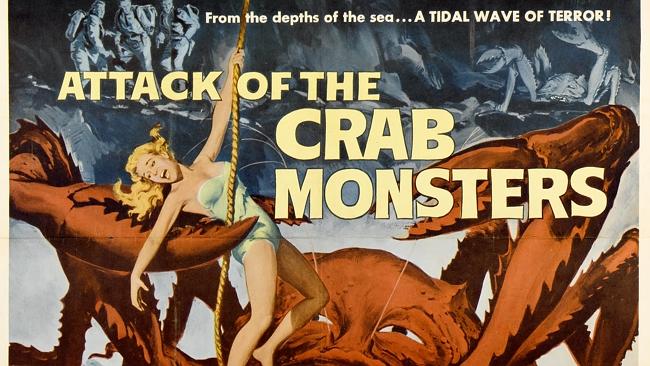IN the opening pages of Chris Nashawaty’s highly entertaining book about Roger Corman, John Landis tells a story about his first meeting with the master of the B-movie. It was 1971, and 21-year-old Landis was trying to raise money to make his debut feature, Schlock, a parody of low budget ape-man movies.
To his surprise Corman not only agreed to meet him but said several complimentary things about Landis’s screenplay. But he also said it was too short and, more important, would benefit from the addition of several scenes in which the ape-man character encountered bare-breasted women.
Landis laughed, thinking Corman was joking. Then he realised he wasn’t.
It’s an anecdote that appeals to the common perception of Corman, the man behind movies such as Attack of the Crab Monsters, Little Shop of Horrors, Teenage Caveman and Gas! Or It Became Necessary to Destroy the World to Save It, as a hack with a taste for ridiculous rubber aliens and scantily clad women, the king, as the subtitle of Nashawaty’s book puts it, of the B-movie.
But it’s also an anecdote that, in its combination of bemusement and respect, serves as a reminder of Corman’s curiously ambiguous legacy: his career shaped not just 20th (and indeed 21st) century popular culture but also the careers of others.
At least part of the pleasure of Crab Monsters, Teenage Cavemen and Candy Stripe Nurses is the deft way it balances these competing qualities, counterpointing a genuine affection for the more ludicrous aspects of Corman’s oeuvre with an awareness of this wider importance, drawing together reminiscences from figures ranging from Martin Scorsese to Peter Bogdanovich, William Shatner, Jack Nicholson and James Cameron, as well as commentary from Corman’s brother and partner, Gene, wife and partner, Julie, and Corman himself.
A half-century ago, when Corman began his career, he would have seemed an unlikely candidate for this sort of celebration. Born in Detroit in 1926, and moving to Los Angeles as a teenager, he studied industrial engineering at Stanford before abandoning the profession in favour of a job in the mailroom at 20th Century Fox.
Corman soon managed to find a job reading scripts, but after his contribution to the rewriting of Gregory Peck’s The Gunfighter went unacknowledged, he quit and went into business for himself. He scored his first real successes with Monster from the Ocean Floor (1954) and the low-budget chase movie The Fast and the Furious (1955). The latter caught the attention of Sam Arkoff from American International Pictures, for whom Corman agreed to provide a steady stream of lurid, cheaply made movies designed for the drive-ins AIP supplied.
During the next few years Corman directed more than 50 films for AIP, churning out titles such She-Gods of Shark Reef and It Conquered the World (notable for one of the silliest aliens created) in a few weeks each (Little Shop of Horrors was famously shot in two days).
Produced on a shoestring and shot with whatever crew or equipment was to hand — in Apache Woman (1955), actor Roger Miller was startled to find himself playing a cowboy and an Indian — these early films are distinguished by the curious combination of absurdity and sincerity that characterises Corman’s best work, marrying an uncanny sense of the audience’s anxieties about nuclear warfare to a pulpy energy and sexiness.
And while the films were largely dismissed by critics, audiences understood their excesses were at least partly ironic: as Scorsese puts it in this book, “You realised the whole genre was being sent up, and you were in on the joke.”
By the 1960s Corman had begun to find respectability of a sort, at least in Europe, where the magnificently creepy series of Poe films that began with The House of Usher (1960) found an appreciative audience. But as his empire expanded into distribution he also became a supporter of new talent, helping newcomers such as Bogdanovich, Shatner, Nicholson and many others by offering them work, often long before they became successful elsewhere.
This role expanded in the 1970s as his New World Pictures became not just the production company behind exploitation flicks such as Death Race 2000 and women-in-prison films such as The Hot Box , but also the US’s biggest distributor of art-house movies, a role in which he brought films by Werner Herzog, Federico Fellini and others to American audiences.
Nashawaty does an admirable job of addressing these many, seemingly contrary strands to Corman’s career, revisiting the important role his guerilla methods and patronage of Henry Fonda, Nicholson and others played in paving the way for the 70s renaissance in American cinema.
But Crab Monsters also serves as a reminder of how Corman’s work was a precursor to films such as Jaws and the blockbuster culture that sounded the death knell of that renaissance.
This tension is what makes Corman and his films such a fascinating conundrum: ridiculous they may be, tawdry, trashy, defiantly tasteless, yet they possess an energy and directness that is missing from the joyless, lumbering blockbusters that rule the cinema screen today. And it’s this same energy that spills from the pages of Nashawaty’s warmly affectionate tribute to one of Hollywood’s most under-recognised figures.
Crab Monsters, Teenage Cavemen and Candy Stripe Nurses: Roger Corman, King of the B-Movie

